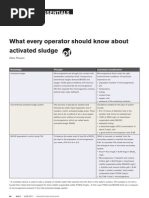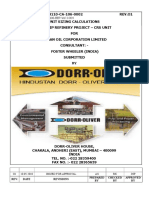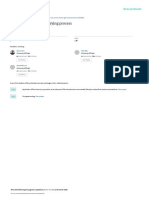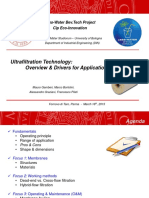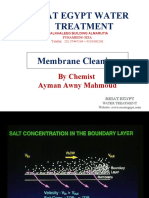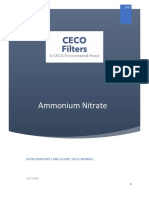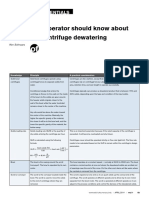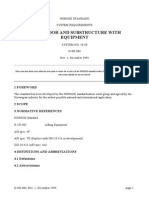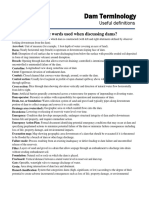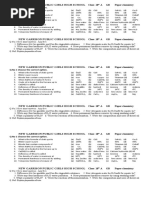0 ratings0% found this document useful (0 votes)
166 viewsReverse Osmosis System Farid
Reverse Osmosis System Farid
Uploaded by
AchFaridWadjdiThis document summarizes a presentation about reverse osmosis systems. It begins with an agenda that includes an overview of reverse osmosis, monitoring reverse osmosis systems, common membrane problems, profiling and probing membranes, and membrane cleaning activities. It then provides details on the reverse osmosis process, types of membranes, monitoring key performance metrics like salt rejection and pressure, common issues like scaling and fouling, techniques for profiling and probing membranes, and steps for cleaning membrane systems.
Copyright:
© All Rights Reserved
Available Formats
Download as PPTX, PDF, TXT or read online from Scribd
Reverse Osmosis System Farid
Reverse Osmosis System Farid
Uploaded by
AchFaridWadjdi0 ratings0% found this document useful (0 votes)
166 views30 pagesThis document summarizes a presentation about reverse osmosis systems. It begins with an agenda that includes an overview of reverse osmosis, monitoring reverse osmosis systems, common membrane problems, profiling and probing membranes, and membrane cleaning activities. It then provides details on the reverse osmosis process, types of membranes, monitoring key performance metrics like salt rejection and pressure, common issues like scaling and fouling, techniques for profiling and probing membranes, and steps for cleaning membrane systems.
Copyright
© © All Rights Reserved
Available Formats
PPTX, PDF, TXT or read online from Scribd
Share this document
Did you find this document useful?
Is this content inappropriate?
This document summarizes a presentation about reverse osmosis systems. It begins with an agenda that includes an overview of reverse osmosis, monitoring reverse osmosis systems, common membrane problems, profiling and probing membranes, and membrane cleaning activities. It then provides details on the reverse osmosis process, types of membranes, monitoring key performance metrics like salt rejection and pressure, common issues like scaling and fouling, techniques for profiling and probing membranes, and steps for cleaning membrane systems.
Copyright:
© All Rights Reserved
Available Formats
Download as PPTX, PDF, TXT or read online from Scribd
Download as pptx, pdf, or txt
0 ratings0% found this document useful (0 votes)
166 views30 pagesReverse Osmosis System Farid
Reverse Osmosis System Farid
Uploaded by
AchFaridWadjdiThis document summarizes a presentation about reverse osmosis systems. It begins with an agenda that includes an overview of reverse osmosis, monitoring reverse osmosis systems, common membrane problems, profiling and probing membranes, and membrane cleaning activities. It then provides details on the reverse osmosis process, types of membranes, monitoring key performance metrics like salt rejection and pressure, common issues like scaling and fouling, techniques for profiling and probing membranes, and steps for cleaning membrane systems.
Copyright:
© All Rights Reserved
Available Formats
Download as PPTX, PDF, TXT or read online from Scribd
Download as pptx, pdf, or txt
You are on page 1of 30
Reverse Osmosis System
Presented by : Ach Farid Wadjdi
3P
Purpose :
To share & discuss Reverse Osmosis (RO) application
Process :
Presentation & discussion
Pay Off :
Better understanding for RO system, Monitoring, Control, and
Services.
2
AGENDA
Reverse Osmosis Overview
Reverse Osmosis Monitoring
Membrane Problem
Profiling and Probing
Membrane Cleaning Activity
3
Reverse Osmosis
Overview
5
Ultrafiltration
Microfiltration
Clarification
Filtration Chlorination
SuspendedParticles
Collodial matter
Organics, Fe&Mn
Bioforms
Electrodialysis
Evaporation
ActivatedCarbon
ReverseOsmosis
IonExchange
Dissolvedions
Hardness
alkalinity
Organics &Res.Cl2
Decarbonation
Chemical Scavenging
Deaeration
DissolvedGases
CO2
O2
H2S, NH3
Contaminants
Contaminant in Water
RO OVERVIEW
6
Osmotic
Pressure
High Low
Semi-
permeable
membrane
OSMOSIS
Applied
Pressure
REVERSE OSMOSIS
High Low
7
Microfiltration Ultrafiltration Nanofiltration Reverse
Osmosis
Range Macro molecular Molecular Sub molecular Ionic
Particle size 1.0 - 0.1 mm 0.1 - 0.01 mm 0.01 - 0.001 mm <0.001 mm
Removes Suspended solids,
Large colloids,
Bacteria
Proteins,
Colloids,
Organics
Pyrogens,
Divalent ions
Virus
Small Organics,
Metals,
Salts
Molecular
Weight
>100,000 10,000 - 100,000 200 - 20,000 <300
Operating
Pressure
10 psig 10 - 100 psig 200 -250 psig 200 - 800 psig
Pretreatment
Needs
Medium Medium High High
Capital Cost Medium Medium High High
Membrane Filtration
Semipermiable Membrane
Thin Film Composite (98% of Industrial market)
Cellulose Acetate
Polysulfone
9
Cellulose
acetate
Thin film
composite
Typical pH range
5.0-6.5 2.0-11.0
Average % rejection
95% 99%
Microbio susceptibility
Yes
No
Temperature limit 35
C 45 C
Chlorine tolerance Excellent Poor
Typical operating
pressure
400 psig 200 psig
Membrane Comparisons
RO System
Train
Pressure Vessel
Stage 2
Stage 1
Reverse Osmosis
Monitoring
12
Point of Monitoring
RO MEMBRANE
PERMEATE
REJECT
HIGH
PRESSURE
PUMP
FEEDWATER
SDI, Feed
Pressure
Feed Flow Rate, pH,
Conductivity, Turbidity,
Temperature, Oxydants,
and Biocide (TFC elements)
Reject
Pressure
Reject Flow
Rate,
Conductivity
Permeate Flow Rate,
Conductivity, Permeate
Pressure, and Biocide
(CA and TFC elements)
1. Percent salt rejection & Percent salt
passage
2. Normalized permeate flowrate
3. Differential pressure
4. % Recovery
Performance monitoring
1. % Salt Rejection & % Salt Passage
% Rejection = (TDS
feed
- TDS
Product
) x 100
TDS
feed
% Salt Passage = TDS
Product
x 100
TDS
feed
Conductivity Factor
TDS
feed
= 0.6 x Conductivity
feed
TDS
permeate
= 0.5 x Conductivity
permeate
TDS
reject
= 0.7 x Conductivity
reject
2. Normalized Permeate Flow
The formula used to calculate Normalized Permeate flow is :
Qnorm = Qi * (NDPstart / NDPi) * (TCstart/TCi)
Qnorm = Normalized permeate flow
Qi = Permeate flow at point i
NDPstart = Net Driving Pressure at startup or reference condition
NDPi = Net Driving Pressure at point i.
TCstart = Temperature Correction Factor at startup or reference condition
TCi = Temperature Correction Factor at point i.
17
= Feed Pressure - Reject Pressure
3. DIFFERENTIAL PRESSURE (P)
18
4. % RECOVERY
% Recovery = (Permeate Flow) x 100 %
Feed/Inlet Flow
Membrane Problem
20
Scaling
The major scalants are calcium carbonate, calcium
sulfate, barium sulfate, silica, and
Calcium/magnesium silicate
Cause: change in pH, salt concentration, dan
temperature.
The best precaution against scaling are optimizing
the pre-treatment, maintaining design flow rate &
continuously injecting scale inhibitor
21
Fouling
Foulants are normally formed from suspended
matter found in the feed water.
To RO membrane manufacturers, fouling is
considered a normal occurrence that can be
controlled with effective monitoring,
maintenance and cleaning programs
22
Degradation or hydrolysis
RO membranes can degrade or hydrolyze when
exposed to oxidants (chlorine; etc.), pH changes,
biodegradation, or temperature extremes.
CA membranes are very sensitive to
biodegradation, pH ranges outside of 5.0 to 6.5,
and temperature higher than 40
0
C.
TFC membranes are very sensitive to oxidizers,
pH ranges outside of 2.0 to 11.0 and temperature
higher than 45
0
C.
Profiling
and Probing
PROFILLING
24
Determined which pressure vessel, has high
contribution to increase permeate
conductivity.
25
Probing : Determines which membrane or interconnector
that has high contribution to conductivity
Using : 1/4
Polypropylene
Tubing
PROBING
1 2 3 4 5 6 7
Reverse Osmosis
Cleaning
When to clean the membranes ?
Decreasing normalized permeate flow 10 15 %
from the last cleaning
Decreasing % Salt Rejection 10 15 % from the last
cleaning
Increasing P 10 15 % from the last cleaning
After 3 month operation
27
CLEANING - OPERATIONAL
Alkaline Cleaning
Remove organic & inorganic fouling
Chemical : PC 98, PC 40 & NaOH for pH adjustment (10,5 12)
Please loading PC 40 first for dilution
Circulate and soak every 15 minutes in interval 4 hours
Record flow, pressure & temperature and maintain within the range
Acid Cleaning
Remove scaling
Chemical : PC 77 & HCl for pH adjustment
Circulate for 2 hours, soak for 30 minutes and then circulate for 1 hour (Pressure max. 4 bar)
Maintain pH during acid cleaning
Record flow, pressure & temperature and maintain within the range
Sanitation
Remove microbiological
Chemical PC 11
Circulate the solution for 60 minutes
28
Before cleaning, please do flushing RO (15 minutes) & circulate (30 minutes) to
cleaning tank with permeate water.
Cleaning Skid
Volume Cleaning :
40-55 m3/membrane
THANK YOU
TERIMA KASIH
MATUR NUWUN
You might also like
- Integrated Shoreline Management Plan Volume 1 Part A BDocument383 pagesIntegrated Shoreline Management Plan Volume 1 Part A BSyahira Rabin100% (2)
- Mini Beet Protocol Robert VonDocument9 pagesMini Beet Protocol Robert VonAA Ayu Anastasya100% (2)
- Types of SeparatorsDocument9 pagesTypes of Separatorsvijayi dhansarNo ratings yet
- WET Operator Essentials - Activated Sludge - June '11Document4 pagesWET Operator Essentials - Activated Sludge - June '11Niji Taiyo100% (1)
- UK National Annex To Eurocode 3: Design of Steel StructuresDocument12 pagesUK National Annex To Eurocode 3: Design of Steel Structuresiipmnpti iipm100% (1)
- Process - Quality Liposomal CDocument7 pagesProcess - Quality Liposomal Crmans100% (1)
- WaterDocument33 pagesWaterKritisundar GarnayakNo ratings yet
- Ion Exchange Resins and Adsorbents in Chemical Processing: Second EditionFrom EverandIon Exchange Resins and Adsorbents in Chemical Processing: Second EditionRating: 5 out of 5 stars5/5 (1)
- Silt Density IndexDocument11 pagesSilt Density IndexWilfredo Suarez Torres100% (1)
- Removal of Boron From Waste Waters by Ion Exchange in A Batch SystemDocument4 pagesRemoval of Boron From Waste Waters by Ion Exchange in A Batch Systemx_mentunhienNo ratings yet
- Reverse Osmosis: Pavanmandapaka Asst. Professor Dept. of Civil & Envt. Engg. Upes, DehradunDocument21 pagesReverse Osmosis: Pavanmandapaka Asst. Professor Dept. of Civil & Envt. Engg. Upes, DehradunKetan BajajNo ratings yet
- Applications of Weak Acid Cation Resin in Waste TreatmentDocument9 pagesApplications of Weak Acid Cation Resin in Waste TreatmentSandeep MishraNo ratings yet
- Filtration 5Document90 pagesFiltration 5Solomon DesalegnNo ratings yet
- Edi Sop: Procedure To Turning "ON" RO-EDI System in Auto ModeDocument2 pagesEdi Sop: Procedure To Turning "ON" RO-EDI System in Auto ModePramod PatilNo ratings yet
- Centrifugal Pump Practical ReportDocument21 pagesCentrifugal Pump Practical ReportSlindile HlambisaNo ratings yet
- 4 - Operation of FILMTEC™ Membrane PlantsDocument80 pages4 - Operation of FILMTEC™ Membrane PlantsVIHIKA ENGINEERINGNo ratings yet
- Presentation # 2 RO Process Operating Parameters PDFDocument38 pagesPresentation # 2 RO Process Operating Parameters PDFMahad Qazi100% (1)
- Ion ExchangerDocument13 pagesIon ExchangerMark Jed Dela CruzNo ratings yet
- Unit Sizing Calc For Tanks & Pumps-CPU 040510Document29 pagesUnit Sizing Calc For Tanks & Pumps-CPU 040510balajikrishnanNo ratings yet
- Ultra Filtration Plant2Document2 pagesUltra Filtration Plant2basu_soumen2011No ratings yet
- 5 Most Common Problems With An RO System and Their SolutionsDocument3 pages5 Most Common Problems With An RO System and Their SolutionsRahul ChandrawarNo ratings yet
- CoagulationDocument70 pagesCoagulationMoazzamNo ratings yet
- Ion ExchangeDocument66 pagesIon ExchangeTsebe HermanNo ratings yet
- 7.operational Problems PDFDocument42 pages7.operational Problems PDFDeva VaraNo ratings yet
- 21810, Ultrapure Water Breakpoint CL andDocument5 pages21810, Ultrapure Water Breakpoint CL andWaleed EmaraNo ratings yet
- Ceramic Membranes. MBR. Likuid NanotekDocument4 pagesCeramic Membranes. MBR. Likuid NanotekAntonio SempereNo ratings yet
- DisinfectionDocument20 pagesDisinfectionSona Parveen FarooqueNo ratings yet
- Energy Saving in Spray Drying ProcessDocument15 pagesEnergy Saving in Spray Drying ProcessJorge OsorioNo ratings yet
- Gomez - Payongayong-Filtration-ESE144 - AutosavedDocument56 pagesGomez - Payongayong-Filtration-ESE144 - AutosavedMaha GomezNo ratings yet
- Evaluating The Performance of Water Treatment PlanDocument9 pagesEvaluating The Performance of Water Treatment Planghina aldilaNo ratings yet
- 16 - Residual Chlorine and Chlorine DemandDocument29 pages16 - Residual Chlorine and Chlorine DemandHayden Chappelear-RobbinsNo ratings yet
- Aspen Repot Lab 4Document8 pagesAspen Repot Lab 4Mohd Hisyamuddin Mohd AminudinNo ratings yet
- Cartridge Filter Application NotesDocument5 pagesCartridge Filter Application NotesSamik MukherjeeNo ratings yet
- Water ChemistryDocument24 pagesWater ChemistryNagaraju BasaNo ratings yet
- Pump Sizing Calculator GuideDocument18 pagesPump Sizing Calculator GuideK LandryNo ratings yet
- Fundamentals of Electrodeionization (EDI) Technology: by Chris Gallagher Applied Water Solutions, Inc. WQA 2008Document31 pagesFundamentals of Electrodeionization (EDI) Technology: by Chris Gallagher Applied Water Solutions, Inc. WQA 2008Algirdas BaranauskasNo ratings yet
- Dw-19 Membrane WB 10 07Document75 pagesDw-19 Membrane WB 10 07TOMMY TOMIWA100% (1)
- Ultrafiltration Technologies PDFDocument18 pagesUltrafiltration Technologies PDFBurak GülenNo ratings yet
- Coagulation and Flocculation in Water and Wastewater Treatment - IWA Publishing PDFDocument27 pagesCoagulation and Flocculation in Water and Wastewater Treatment - IWA Publishing PDFНурбек КасимовNo ratings yet
- Equipment Catalogue API Oil SeparatorDocument2 pagesEquipment Catalogue API Oil Separatorbesant vargheesNo ratings yet
- Microfiltration (MF), Ultrafiltration (UF)Document52 pagesMicrofiltration (MF), Ultrafiltration (UF)WONG TS80% (5)
- A Practical Guide To Investigate Problems On Polishing Mixed Bed PDFDocument5 pagesA Practical Guide To Investigate Problems On Polishing Mixed Bed PDFengp1922100% (7)
- The Principal Filtration Methods Now Used With Reference To The Rate of Flow Through Gravity Filters May Be Classified AsDocument6 pagesThe Principal Filtration Methods Now Used With Reference To The Rate of Flow Through Gravity Filters May Be Classified AsiastraNo ratings yet
- Data NormalisationDocument31 pagesData NormalisationAshish GulabaniNo ratings yet
- Nanofiltration and Reverse OsmosisDocument2 pagesNanofiltration and Reverse OsmosisJimmy Hend KhratNo ratings yet
- Reverse OsmosisDocument82 pagesReverse OsmosisankurfazilkaNo ratings yet
- Membrane Fouling &cleaning AymanDocument32 pagesMembrane Fouling &cleaning AymanCarlos EstévezNo ratings yet
- System OperationDocument34 pagesSystem OperationFranklin Revill100% (2)
- Optimum Sizing of Cooling TowersDocument7 pagesOptimum Sizing of Cooling Towerssohailffc100% (1)
- Topic 6 - Water TreatmentDocument57 pagesTopic 6 - Water TreatmentYousef ZamNo ratings yet
- Design and Operation Considerations For Condensate Polishing - T5S5O3-paper PDFDocument17 pagesDesign and Operation Considerations For Condensate Polishing - T5S5O3-paper PDFNhhVuNo ratings yet
- CECO Filters - Ammonium Nitrate Applications ManualDocument35 pagesCECO Filters - Ammonium Nitrate Applications ManualabsahkahNo ratings yet
- Water Treatment BasicsDocument62 pagesWater Treatment Basicsanac_mathNo ratings yet
- Cleaning Procedure HydranauticsDocument5 pagesCleaning Procedure Hydranauticsmirza_adil99No ratings yet
- WET Operator Essentials - Centrifuges - April - 14Document3 pagesWET Operator Essentials - Centrifuges - April - 14TONNo ratings yet
- Grease Trap Installation Operation Maintenance PDFDocument5 pagesGrease Trap Installation Operation Maintenance PDFfrankcysNo ratings yet
- Basics of Reverse Osmosis PrincipleDocument6 pagesBasics of Reverse Osmosis Principlezerocool86No ratings yet
- RELITE 3AS - Strongly Basic ResinDocument2 pagesRELITE 3AS - Strongly Basic ResinPanca Erlangga SiregarNo ratings yet
- Ammonia Removal From WastewaterDocument6 pagesAmmonia Removal From WastewaterJunaid AmeerNo ratings yet
- Filtration OptionsDocument5 pagesFiltration OptionssyeddanishrasoolNo ratings yet
- Treatment of Water: 4 Process Will Be Used To Treat Waste Water in Steel IndustryDocument19 pagesTreatment of Water: 4 Process Will Be Used To Treat Waste Water in Steel IndustryReshab SahooNo ratings yet
- J. Mathematical Model of Once Through MSF: T, Is Obtained From The Relation T (To-Tn) /NDocument11 pagesJ. Mathematical Model of Once Through MSF: T, Is Obtained From The Relation T (To-Tn) /NTino UmbarNo ratings yet
- Table of Dream-Farid RimaDocument5 pagesTable of Dream-Farid RimaAchFaridWadjdiNo ratings yet
- Resume GuideDocument6 pagesResume GuideAchFaridWadjdiNo ratings yet
- Sample MarketingDocument3 pagesSample MarketingAchFaridWadjdiNo ratings yet
- Drillfloor and Substructure With EquipmentDocument4 pagesDrillfloor and Substructure With EquipmentAchFaridWadjdiNo ratings yet
- Haccp Plan Canned Tuna - Group 5Document54 pagesHaccp Plan Canned Tuna - Group 5ScribdTranslationsNo ratings yet
- Testbank Environmental Science c11Document13 pagesTestbank Environmental Science c11nxhanhNo ratings yet
- XyxoDocument2 pagesXyxoเปี๊ยก คนเดิมNo ratings yet
- Risk-Assessment-for-Elemental-Impurities-of-Allopurinol-300-mg-TabletDocument14 pagesRisk-Assessment-for-Elemental-Impurities-of-Allopurinol-300-mg-TabletdamilolamathiasNo ratings yet
- Drainage Structures' Sizing GuidelinesDocument45 pagesDrainage Structures' Sizing GuidelinesSimon MuliisaNo ratings yet
- CE 374 K - Hydrology CE 374 K Hydrology: Stream and Reservoir RoutingDocument19 pagesCE 374 K - Hydrology CE 374 K Hydrology: Stream and Reservoir RoutingMamuye Busier YesufNo ratings yet
- Steps For The Production of Potassium Chlorate For The Amateur ChemistDocument18 pagesSteps For The Production of Potassium Chlorate For The Amateur ChemistBitter_Armadillo0% (1)
- 03E. COP Well Selection Guidelines (Excellent)Document66 pages03E. COP Well Selection Guidelines (Excellent)Donald StraubNo ratings yet
- Dam Terminology PDFDocument2 pagesDam Terminology PDFYoungSpiritNo ratings yet
- Msds Wbp-1621-01 SL BlackDocument4 pagesMsds Wbp-1621-01 SL BlackFindora InternusaNo ratings yet
- Concrete MaterialDocument38 pagesConcrete MaterialRwitika TarafderNo ratings yet
- Class-9 IS MATTER AROUND US PUREDocument27 pagesClass-9 IS MATTER AROUND US PUREAniiNo ratings yet
- Ais 2021-2022 Gr-7 Sci Term 2 RevisionDocument8 pagesAis 2021-2022 Gr-7 Sci Term 2 RevisionMitalNo ratings yet
- Yxnv Wy AEjDocument3 pagesYxnv Wy AEjDR-Bassem FayezNo ratings yet
- Brief Note On Water & Sewerage System at PaliDocument4 pagesBrief Note On Water & Sewerage System at PaliPrashantNo ratings yet
- Bio Disc by DR ShakeelDocument44 pagesBio Disc by DR ShakeelJamal TahirNo ratings yet
- Water Quality TestingDocument18 pagesWater Quality TestingSohel BangiNo ratings yet
- Deependra Environment Project Final PDFDocument20 pagesDeependra Environment Project Final PDFBeing IndianNo ratings yet
- ASTMDocument2 pagesASTMNeinelia GuerraNo ratings yet
- 10h Chemistry CH - No. 15 + 16Document1 page10h Chemistry CH - No. 15 + 16Ahsan aliNo ratings yet
- A New System of Chemical Philosophy by Sir DaltonDocument247 pagesA New System of Chemical Philosophy by Sir DaltonEndi BytyqiNo ratings yet
- MSDS PermaClean PC-33Document10 pagesMSDS PermaClean PC-33evgdamNo ratings yet
- NSTP - Environmental Protection and ManagementDocument3 pagesNSTP - Environmental Protection and ManagementDale Imperio100% (1)
- DLL - Science 4 - Q1 - W8Document4 pagesDLL - Science 4 - Q1 - W8Flordiles NavarroNo ratings yet
- Geography AssignmentDocument9 pagesGeography Assignmenthum aur hamari lifeNo ratings yet
- Hidrología de Paleocrecidas Aplicada Al Cálculo de La Avenida de Diseño y Avenida Máxima de PresasDocument7 pagesHidrología de Paleocrecidas Aplicada Al Cálculo de La Avenida de Diseño y Avenida Máxima de PresasGIANCARLO ULDARICONo ratings yet



